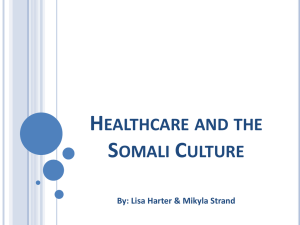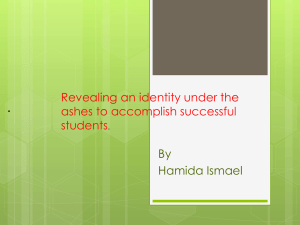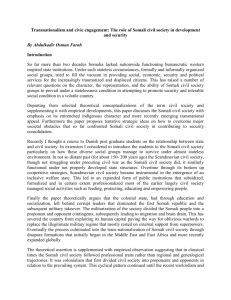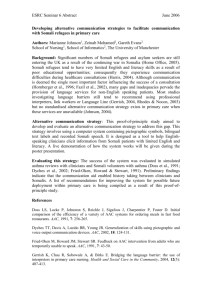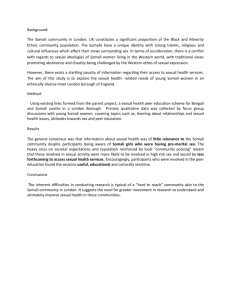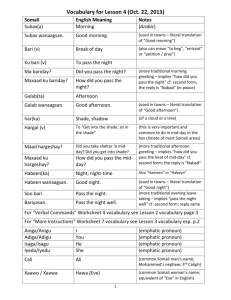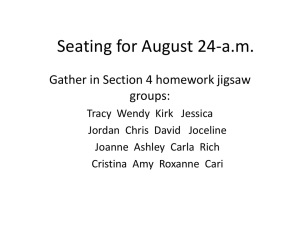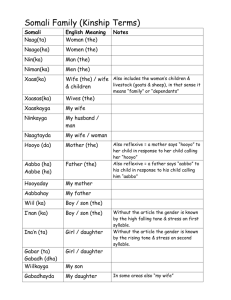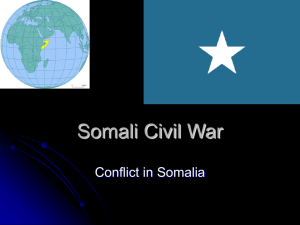The Internet and the Somali Diaspora: The Web
advertisement
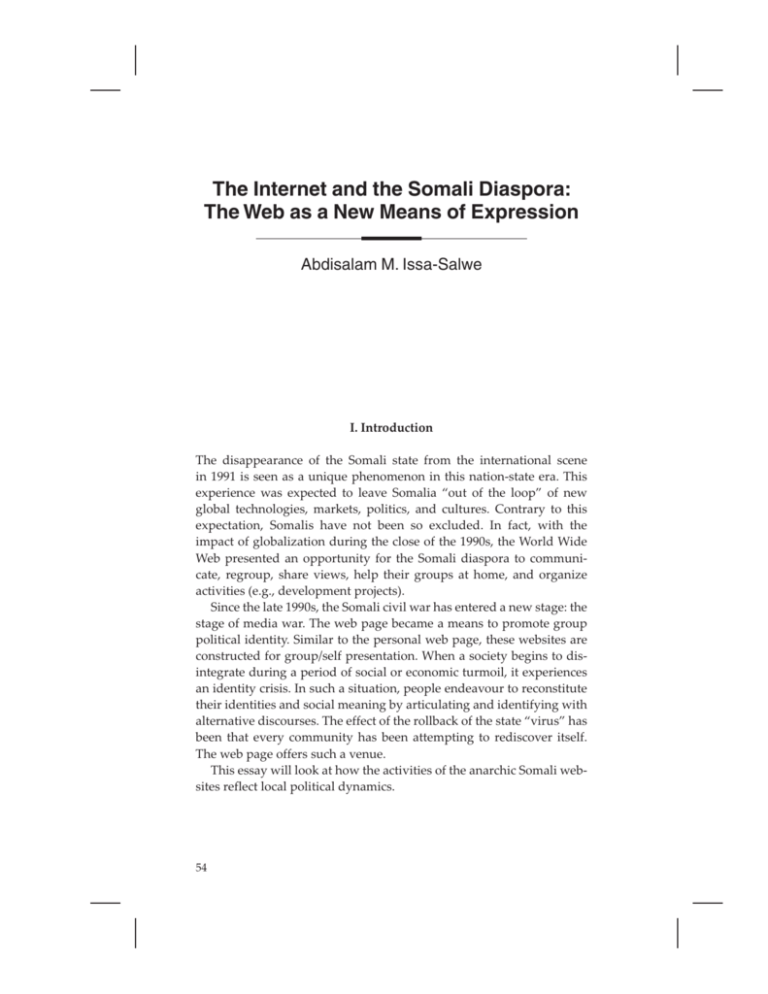
The Internet and the Somali Diaspora: The Web as a New Means of Expression Abdisalam M. Issa-Salwe I. Introduction The disappearance of the Somali state from the international scene in 1991 is seen as a unique phenomenon in this nation-state era. This experience was expected to leave Somalia “out of the loop” of new global technologies, markets, politics, and cultures. Contrary to this expectation, Somalis have not been so excluded. In fact, with the impact of globalization during the close of the 1990s, the World Wide Web presented an opportunity for the Somali diaspora to communicate, regroup, share views, help their groups at home, and organize activities (e.g., development projects). Since the late 1990s, the Somali civil war has entered a new stage: the stage of media war. The web page became a means to promote group political identity. Similar to the personal web page, these websites are constructed for group/self presentation. When a society begins to disintegrate during a period of social or economic turmoil, it experiences an identity crisis. In such a situation, people endeavour to reconstitute their identities and social meaning by articulating and identifying with alternative discourses. The effect of the rollback of the state “virus” has been that every community has been attempting to rediscover itself. The web page offers such a venue. This essay will look at how the activities of the anarchic Somali websites reflect local political dynamics. 54 Abdisalam M. Issa-Salwe II. Social Aspects and Web Environment Computer-mediated communication has introduced a new social environment. It helps to create online links in ways that have never been possible through traditional media. From an individual perspective, websites can be seen as the ultimate in individualism, a medium with the capability to empower the individual in terms of both the information that he/she seeks and the information he/she creates.1 One of the benefits of the Web is that people can break the bond of geography; they can “meet” and “talk” electronically, if not face-to-face, with people of similar interests all over the world. Unlike printed and broadcast media, web pages are not only published (on a grand scale) but are also easily revisable.2 Web pages can include not only text, but also graphics (still and moving, photographs, cartoons, and artwork) and sound (voices, music, and sound effects).3 Web pages are more dynamic than print and broadcast media. The instant mutability of online material conjures up a sense of these web pages being part of their authors. The existence of computer-linked communities was predicted some twenty years ago by J. C. R. Lickhder and Robert Taylor, who, as research directors in the U. S. Department of Defense, set in motion the research that resulted in the creation of the first such community, the ARPANet.4 They explain: What will on-line interactivity communities be like?…in most fields they will consist of geographically separated members, grouped in small clusters and sometimes working individually. They will be communities not of common location, but of common interest.”5 As they exist today, virtual communities are groups of people who may or may not meet face-to-face, and who exchange words and ideas through the mediation of computer bulletin boards and networks.6 This aspect of communication is perhaps the most important feature of this new “space.” As mentioned before, computer-mediated communication (CMC) has added a new dimension to the pattern of communication within the Somali diaspora. In another setting, this CMC unites individuals to share online identities through the aggregate networks of relationships and commitments that make any community possible. Rheingold maintains: 55 Bildhaan Vol. 6 The physical world, known variously as ‘IRL’ (In Real Life) or ‘offline,’ is a place where the ‘identity’ and position of the people you communicate with are well known, fixed, and highly visual. In cyberspace, we can only exchange words with each other…on top of the technology-inspired constraints, we, who populate cyberspace, deliberately experiment with fracturing traditional notions of identity by living as multiple simultaneously personae in different virtual neighbourhoods…We reduce and encode our identities as words on a screen decode and unpack the identities of others.7 Generally, the shared identity born of the virtual community is temporal. However, a group of Somalis using the CMC may create a virtual community, which also has another relationship: that of a specific group identity—one, in turn, backed by the real world (or offline relationships). Self-presentation research has been profoundly influenced by the sociologist Erving Goffman and his metaphor of dramatic performance in everyday life. Döring contends that being represented on the Web in an appealing way may enhance the impression one makes on unfamiliar people.8 Personal home pages can be implemented to convey an impression of one’s own person and personal identity to certain audiences and addressees, and to improve contact opportunities and networking.9 But they can also be public relations for a certain collective identity or a marginalized social group whose public image one would like to present.10 Thomas Erickson comments: While personal portrayal is a new type of usage of the web, it is very ordinary behaviour in the real world. People go to considerable effort and expense to manage their appearance. Portrayal management ranges from the ways in which people act in public, to the clothes they wear and the goods they possess and consume. The World Wide Web is one of the first venues where individuals can construct portrayals of themselves using information rather than consumer goods as their palette.11 III. Somali Diaspora and the Social Web Environment In this epoch of social crisis, the Somali diaspora is dependent on the media for information. One such medium is CMC, which has added a new dimension to the patterns of face-to-face oral communication within the Somali diaspora and influenced how these Somalis perceive themselves and the world. 56 Abdisalam M. Issa-Salwe Marshall McLuhan describes communication media as an extension of the senses, and argues that the “sensory balance” of the people in a culture alters their consciousness. Meyrowitz stresses that media creates a “new social environment” that is no longer shaped by the physical location and physical presence. For example, in Somalia, telephone and other communication media have altered the functional significance and effects of earlier media, such as oral messages, letter writing, and taped transmissions. Despite focusing on the diaspora, the material published on the Internet may often originate in Somalia, where it is frequently published simultaneously in local newspapers. Many local newspapers have their own websites or have access to the Web where they publish their news. Some of these are Jamhuriya in the North (Somaliland), Kaaha Bari in the Northeast (Puntland), and Qaran in Mogadishu. The majority of Somali websites are managed from outside of the country. This is not to say that all Somali websites, particularly the community/political web types, are neutral or independent. Some, in fact, are funded by local businessmen and the politically aspirant. Besides that, there is also a fee to obtain a web host (i.e., the domain to host the files) and the Internet Service Providers (ISP) usually require payment in foreign currency. During the civil strife in Somalia, a large portion of the population was forced to flee their country. Yearning for communication became a priority for these people. The CMC expansion coincides with this period and it seems that it helped to fill the needs of the Somalis who fled their homes. However, this led them to organize in communication terms what Lee Cassanelli calls, “the factionalism of Diaspora.”12 A look into the Somali diaspora in Europe and North America suggests some of the ways that diasporan groups are linked to and shape the dynamics of conflicts. The overall Somali community in North America and Europe is estimated at nearly a million, with a large concentration in the United States, Canada, and the United Kingdom.13 These migrants are characterized by the source of their displacement (violent, forced separation rather than relatively voluntary migration based on the pursuit of economic incentives) and by the consequent nature of their ties to the homeland. The migration has come in waves, with the first wave in the early 1970s, following the repression by the military regime in the northeastern regions of Somalia first and later in the northern zones of the country. With the civil war and state collapse in the early 1990s, the wave increased dramatically. At least one-third 57 Bildhaan Vol. 6 of the Somali population is believed to have either fled the country or been internally displaced. The involvement of migrants and exiles in the political affairs of their homelands is not new and has taken many forms over the centuries. As the pace and scale of globalization has increased in recent years, the location of key political, economic, and social developments is often outside the sovereign territory of a given state.14 This is distinct from the pattern of many economically driven migrations, in which only subsets of a community (such as the young men or young women) migrate.15 IV. Somali Web Proliferation In Somalia relatively few people have the means to access the Internet, while in the diaspora the reverse is true. However, some of the information published on Somali websites—particularly community/ political websites—reflects the local political dynamics. Several factors leading to this outcome include: (1) many of the political elite, who have been the main protagonists in Somali politics, are taking advantage of this new communication medium; (2) educated Somalis have the chance to learn about and use the Internet; and (3) the civil strife has coincided with the boom in Internet technology. Somalis are adept at adapting technologies to their situational needs. In mid-2004, there were over 400 Somali websites, and it seemed that every so often new ones appeared. Many have noted this trend. One of them is Ismail A. Hassan, a Somali Internet student, who says, “waxaana maalinba maalinta ka dambeysa sii badanaya shabakadaha Soomaalida” (day by day the numbers of Somali websites are increasing). There appear to be two main reasons for the proliferation of Somali websites: (1) the loss of national identity following the collapse of the state institutions, and (2) the characteristics of the Internet that make it more accessible are participatory and conducive to oral expressiveness. The current social crisis among the Somalis has created a situation that voids social norms, and many individuals are left in disarray, in mental and moral confusion. The proliferation of Somali websites presents an answer to this new situation in which sub-national groups are attempting to re-create themselves. In essence, the process of making web pages amounts to the construction of identities. Creating such 58 Abdisalam M. Issa-Salwe pages offers an unrivalled opportunity for group-presentation (or selfpresentation) in relation to any dimension of social and personal identity to which one chooses to allude.16 V. Common Somali Website Features According to their structure, form, activity, and content, Somali websites can be classified into seven categories: 1. Professional/business (pro/bus) This web type is devoted mainly to professional or other specific activities, such as business. 2. Online News (on-news) This web type is structured in the form of an online newspaper, publishing news in the form of text or audio. 3. Religious (rel) This group is dedicated entirely to Islamic teaching and information. 4. Personal (per) This web type has the most striking similarity with the political/community web type (see below), as personal web pages are known to present material in self-presentation form. 5. Radio/TV (rad/tv) The Radio/TV web type group has some similarities with the online news web group. 6. Community/political (com/pol) By focusing on community views, concerns and interest, the community/political web type behaves as a community and political front. 7. Cultural/literary (cul/lit) This web type devotes its activity to Somali culture and literature. • All seven categories run different services. Although some may overlap, distinctive features mark each as a category in its own right. 59 Bildhaan Vol. 6 Table 1: Somali Website Category (November 2004) Category Number Percentage community/political culture/literature Rel Pro/bus Rad/tv On-news Per 203 18 19 62 35 24 166 38.52% 3.42% 3.61% 11.76% 6.64% 4.55% 31.50% Total 527 Common features that can be found in almost all categories are the literary and Islamic sections. These two features demonstrate the importance that Somalis give to these most enduring elements of their heritage. Accompanying these features is the audio facility that is used by many categories. The audio uses an analogue of oral media. Whether this new technology will shift the balance from print to audio (words) is not yet clear. Nevertheless, because of Somali oral tradition, it would have a major impact. In fact, during this research, there has been a major development wherein many websites have added the audio feature to their service. Running the service similarly to radio, they usually utilize the audio feature for interviews and Islamic teachings. One important section is the political comment/analysis/opinion section in which users’ opinions are published. This genre is becoming very popular by creating an opportunity for young writers to air 60 Abdisalam M. Issa-Salwe and publish their opinions and ideas. This medium has the potential to encourage people to read and comment. The opinions of community/political websites attract many Somalis throughout the diaspora. Writings about contemporary political issues are found in this section. Contemporary political issues are always “hot,” so many people try to reply. Some of these replies are published next to the article to which they are responding, with potential for reinforcing differences as well as reconciling them. The languages that websites use are overwhelmingly Somali and English. The website gives notice that the opinions contained in every article are solely those of the writer and do not necessarily represent the editorial opinions of the website. Despite this statement, the suspicion is that the website may be sympathetic to the views and opinions of the writer. Forum features enable users to post their comments so other users can read or comment. Some of these comments may form part of an important debate in which people with different views write about timely issues. Alternately, the chat service is “real time” communication between two users via computer. Once a chat has been initiated, either user can enter text by typing on the keyboard and the entered text will appear on the other user’s monitor. Most networks and online services offer chat features. VI. Naming Conventions Web naming is one of the major aspects defining Somali websites. There are a number of naming conventions associated with Somali websites, depending on the web group. It seems that naming is influenced by the internal political mood. For example, the end of the 1990s and early 2000s coincided with a time of social disintegration and the roll back of the state, which led to identity crisis. Identifying with the kin-group or region has become a common characteristic of contemporary Somali society. This kind of circumstance is a major reason behind the naming conventions of Somali websites. Such naming is usually related to group, regional, or clan interest. Generally, web-naming conventions can be classified as the following: a. Organizational, geographical, regional, or clan: this kind of web naming usually corresponds to a website’s political or regional affili- 61 Bildhaan Vol. 6 ation. They may also depict geographical areas like a region or town. Examples include: SomalilandForum (www.somalilandforum.com), Arlaadinet (www.arlaadinet.com), Puntland Intelligensia Network (www.puntin.com), and Dayniile (www.dayniile.com). Under this naming group, there are also those which demonstrate community websites, e.g., Somaliland Women’s Association. b. Professional: usually used by businesses or institutes. Good examples are Dahabshiil or Amoud University. Names that are usually given to Radio/TV groups also come under this category. c. General: these carry general names that do not describe a particular group. Included here are, for example, SomaliNet, SomaliTalk, or Somalia Online. There are, however, some websites that disguise their political or regional affiliation. In the first half of the year 2000, there were an increasing number of web names that identified themselves with such themes as patriotism or nationalism. Two of these sites are Midnimo and Wadani. This new phenomenon demonstrates a change in naming conventions since Somali websites take on specific organizational or group affiliation. d. Literary/cultural: this kind of website suggests literary or cultural content, e.g., MandeqNet.com or HoygaSuugaanta.com. It is commonly made in the honour of culture, literature, or a well-known literary person like Muuse Galaal or Mohamed Ibrahim Warsame “Hadraawi.” e. Religious: this usually underscores Islamic sites or historic events. Moreover, the naming emphasizes religious sermons, such as Wacdi. f. Personal: This naming is usually in search of humour and extreme informality. VII. Why the Proliferation of Somali Websites? In 1998, there were fewer than twenty Somali websites; there are now as many as 527 listed, of which 38 percent have been categorized as community/political types. Next come the personal home pages (32 percent). Many of these home pages have been created by students in order to improve their Web skills. In the early years of the 1990s, in many parts of Europe and North America, there were also efforts to create clanist local newspapers. 62 Abdisalam M. Issa-Salwe However, almost none survived beyond the first year or first four issues. The only exception is Kasmo, an independent and non-partisan newspaper, which was founded on September 27, 1997. Its survival relies on publishing for a wider audience. Web designing has been more successful than printing. The economics of print requires a good system of dissemination. From a publishing standpoint, an electronic newspaper can reduce the cost and time required to publish, update, and store information. In addition, electronic text is less expensive and less time-consuming to produce and revise. Users can access the updated information faster. Not only can electronic storage and retrieval reduce production costs, they also reduce the amount of space necessary to store documents. In addition, publishing on the Internet is automatically available on a global stage. Unlike print, web pages include not only text, but also sound. Web pages are more dynamic than print, and they are easily revisable. The Internet’s multifaceted character has provided members of the Somali diaspora with contradictory ways of presenting their anguish and emphasizes the prominence of the oral. But each site represents part of the total sum of this turbulent history by strengthening the sense of a specific community as well as helping to keep the notion of a Somali nation alive. The explanation for the proliferation of Somali websites can also be found in Somali culture within the stateless situation. Had the Internet been discovered before the inception of the modern Somali state, Somalis could have been the first people to populate the Internet. This is because every kin-group would have a presence on the Web. This experience could be viewed through the centuries-old Somali egalitarianism. Since the idea of equality permeates all aspects of society, “sometimes to the point of anarchy,”17 website proliferation is normal because the Internet provides Somalis with a new dimension of expression. Awes A. Osman writes: Since the emergence of the Internet and its introduction to the Somali society, there are as many Somali Internet sites as the total number of clans, sub-clans, and sub-sub-clans. The interesting feature is that each Internet site corresponds to the political interests of a particular clan or sub-clan except for a very few sites that choose to stand neutral.18 63 Bildhaan Vol. 6 In the 1990s, Somalis found themselves in a period of social division and disintegration in which the sub-national forces took over where the state left off. This mood contradicted the ambience that bred Somali nationalism in the 1940s and 1950s. In the process of “reinventing the clan,” it is common for many community/political websites to employ an approach like that of Somali nationalism in the 1940s, but in a different format. To bolster the clan image, they present pictures of some of their prominent members. As an example, Geldogob has the picture of Professor Said Sheikh Samatar, of the Department of History at Rutgers University, whose remarkable work includes research on oral poetry and Somali nationalism. Ogaden Online features General Aden Abdullahi Nur, former Minister of Defence, who became a leader of the southern-based Somali Patriotic Movement. The two most remarkable websites using this approach are Mudulood (www.mudulood.com) and Midgaan Online (www.midgaan.com). Mudulood.com has a long list of prominent national politicians and heroes. One of these is Aden Abdulle Osman, the first African president to relinquish power after he was defeated in an election.19 The list also includes General Daud Abdulle Hirsi, a national hero and the first commander of the Somali National Army in the early 1960s; Ismail Jimale Osoble, a well-respected human rights lawyer; Osman Ahmed Roble; Ali Gedi Shador; and Ali Mohamed Ghedi, who was selected as TFG Prime Minister of Somalia in 2004, following a long Somali reconciliation conference held in Kenya. The list also includes minor civil servants. If Mudulood figures are mainly from the political class, Midgaan Online has chosen completely different figures. They are, instead, prominent figures in Somali art and literature from the marginalized communities. These include distinguished individuals such as the singer and lute player Omar Dhuulle and the performer Maryan Mursal Issa. The significant point here is that Midgaan Online does not include political figures. It has not even included General Mohamed Ali Samantar, the able and charismatic Vice President under Siyaad Barre’s regime. The primary intention of the site is to present the positive contributions of a long ostracized people. This is what they say: Being Midgan in Somalia is not a happy existence; it means trying to smile when you want to cry, it means to hold on to physical life in the midst of psychological death. It means pain by watching your children growing up in an environment that dehumanizes them by devaluating 64 Abdisalam M. Issa-Salwe their worth just because they are born to Midgan or Tumaal families. What future awaits such children?20 Despite the prejudice, these Somali groups are best known for their craftsmanship, creativity, bravery, and wit. VIII. The Website and News Responsibility The way information is dealt with by Somali webmasters reflects the traditional way of treating information as a commodity. Somalis say, “warbaa ugu gaaja wayn” (information hunger is the worst hunger). This makes one a potential source of precious news and, therefore, a good “handler.” However, many Somali community/political websites fail at this characteristic. Significant Somali websites lack the resources to manage as media organizations. Therefore, accuracy and other crucial elements of the news industry might not be maintained. Somali media appears to vacillate between excessive exercise of its freedom in some spheres and drastic control in other spheres. The view of journalistic freedom relates to self-regulation and responsibility toward the society. Particularly at a time of social strife, the desire for freedom is weighed against the need to preserve political stability and social harmony. Many practitioners have the opinion that the media should not be controlled at all, yet accept that they should take responsibility for what they publish. In other words, they should selfregulate. IX. Conclusion While the Internet creates a sense of belonging and sharing for Somali groups, it is also an agent for the fragmentation of Somali society. While Somali websites tend to depict cherished cultural homogeneity and the shared heritage of Islam, they also portray political and social divisions. A group is held together by what it has in common. Information sharing is one important method through which commonality is reinvented and strengthened. But, in the Somali context, there is also the play of different interpretations of history in a time of generalized chaos. Consequently, Somali websites capture the turbulence of a contradictory time of collective identity and fragmentation. 65 Bildhaan Vol. 6 Notes 1. Noblia 1998. 2. Chandler et al., November 1998. 3. Ibid. 4. Ibid. 5. Quoted in Rheingold 1992. 6. Ibid. 7. Ibid. 8. Goffman 1959 and Döring 2002. 9. Erickson, 1996. 10. Hervern 2000. 11. Erickson 1996. 12. Cassanelli 2002. 13. Cultural Orientation Net, 02/08/04. 14. Foner 2000. 15. Lyons 2004. 16. Quoted in Chandler 1997. 17. Lewis 1961. 18. Osman, July 2005. 19. Samatar et al. 2004. 20. Keynan 2004. Bibliography Abdulkadir, Osman Farah, and Ali Abdi Yusuf. “Hadraawi’s Peace Journey (Socdaalka nabadda) Reaches Aarhus, Denmark.” 30 March 2004. Accessed online on 30 November 2004 at http://www.hiiraan.ca/2003/nov03/hadrawi_den.htm?ID=46923. Academy for Peace and Development. “The Role of the Media in Political Reconstruction.” Hargeisa, Somaliland. July 2002. Adam, Hussein M. “Language, National Consciousness and Identity: The Somali Experience.” In Nationalism and Self-Determination in the Horn of Africa, edited by I. M. Lewis. London: Ithaca Press, 1983, pp. 31–42. Cassanelli, Lee. “Emigrants and Homeland Development: The Somali Case in Comparative Perspective.” Paper presented at Il Corno D’africa Fra Storia, Diritto E Politica. Rome, 13–14 December 2002. Chandler, Daniel, and Dilwyn Roberts-Young. “The Construction of Identity in the Personal Homepages of Adolescents.” 2 November 1998. Accessed online on 13 July 2004 at http://www.aber.ac.uk/media/Documents/short/strasbourg.html. ———. “Personal Home Pages and the Construction of Identities on the Web.” 1997. Accessed online on 12 November 2002 at http://www.aber.ac.uk/media/Documents/ short/webident.html. Cultural Orientation Net. “Somalis.” 2 August 2004. Accessed online on 12 November 2004 at http://www.culturalorientation.net/somali/sintro.html. 66 Abdisalam M. Issa-Salwe December, John. “Characteristics of Oral Culture in Discourse on the Net.” Paper presented at the Twelfth Annual Penn State Conference on Rhetoric and Composition, University Park, Pennsylvania. 8 July 1993. Accessed online on 12 December 2002 at http://www.december.com/john/papers/pscrc93.txt. Erickson, T. “The World Wide Web as Social Hypertext.” Communications of the ACM 39, no. 1 (1996): 15–17. Accessed online on 2 September 2004 at http://www.pliant.org/personal/Tom_Erickson/SocialHypertext.html. Foner, Nancy. From Ellis Island to JFK: New York’s Two Great Waves of Migration. New Haven: Yale University Press, 2000. Fowler, Robert M. “How the Secondary Orality of the Electronic Age Can Awaken Us to the Primary Orality of Antiquity Interpersonal.” Computing and Technology: An Electronic Journal for the 21st Century 2 no. 3 (July 1994): 12–46. Accessed online on 20 November 2004 at http://www.helsinki.fi/science/optek/1994/n3/fowler.txt. Hassan (Khaliil), Ismail A. “Internetkaa Lagu Soo Qoray!” 17 November 2004. Accessed online on 21 November 2004 at http://horseednet.com/modules.php?op=modload&nam e=News&file=article&sid=2853. Issa-Salwe, Abdislam M. The Collapse of the Somali State: The Impact of the Colonial Legacy. London: Haan Associates, 1996. Keynan, Ahmed M. “Freedom without Equality: the Midgans.” 2002. Accessed online on 12 December 2004 at http://midgaan.com/azhar.htm. Lyons, Terrence. “Diasporas and Homeland Conflict.” Institute for Conflict Analysis and Resolution. Paper presented to the D.C. Area Workshop on Contentious Politics. March 2004. Accessed online in April 2004 at www.bsos.umd.edu/gvpt/davenport/ dcawcp/ paper/mar0304.doc. McLuhan, Marshall. The Extension of Man: Understanding Media. London: Routledge and Kegan Paul, 1964. McQuail, Denis. Mass Communication Theory: An Introduction. 3rd ed. London: Sage Publications, 1994. Mukhtar, Mohamed Haji. “The Plight of the Agro-Pastoral Society of Somalia. 2001. Accessed online on 12 February 2002 at http://www.arlaadinet.com/D&MHistory/SomaliHistory/plight.htm. Noblia, Maria Valentina. “The Computer-Mediated Communication: A New Way of Understanding the Language.” March 1998. Accessed online on 5 June 2003 at http:// www.sosig.ac.uk/iriss/papers/paper22.htm. Ong, Walter. Orality and Literacy: The Technologizing of the Word. London: Methuen, 1982. Rheingold, H. The Virtual Community: Homesteading on the Electronic Frontier. Reading, Mass.: Addison-Wesley, 1993. Samatar Abdi I., and Ahmed I. Samatar. “Somalis as Africa’s First Democrats: President Aden A. Osman and Premier Abdirazak H. Hussein.” Bildhaan: An International Journal of Somali Studies, Vol. 2 (2002). Accessed online on 12 December 2004 at http://www.radiogalkayo.com/news/first_democrats.pdf. 67
